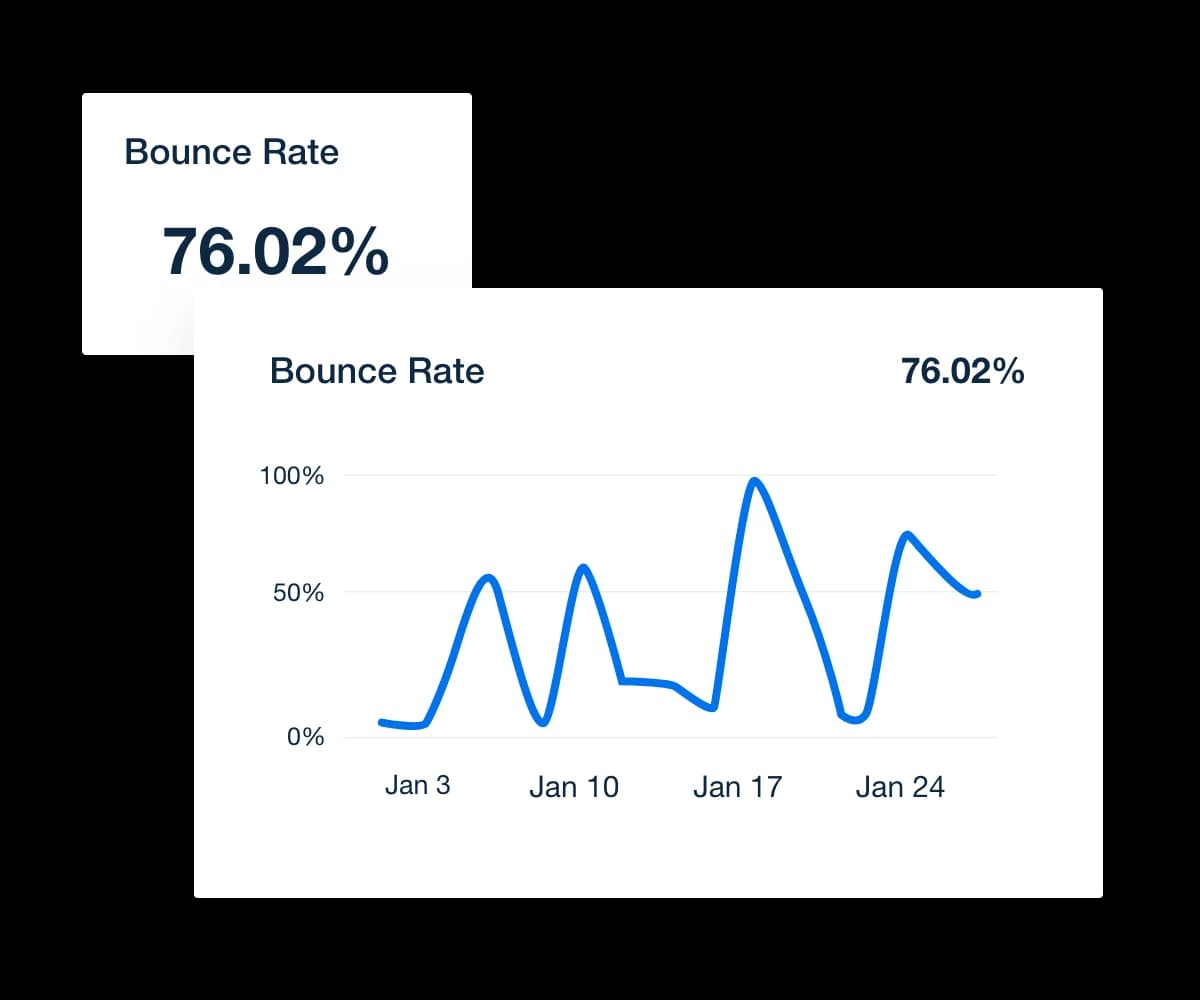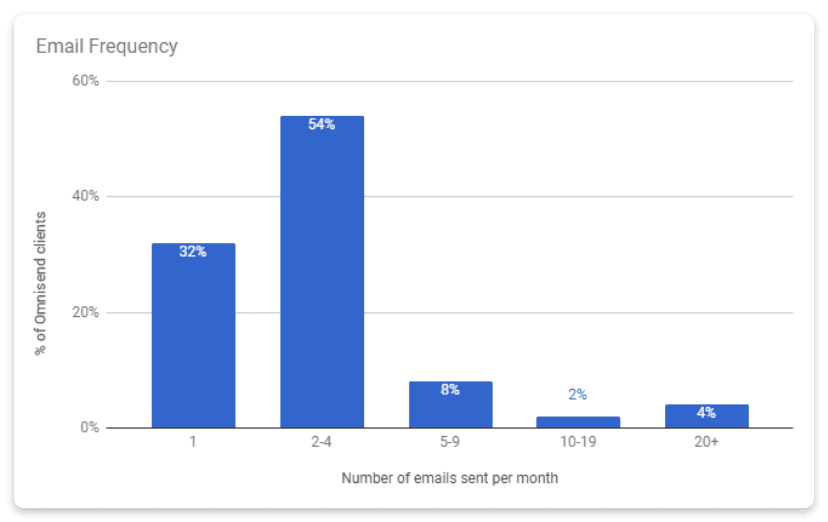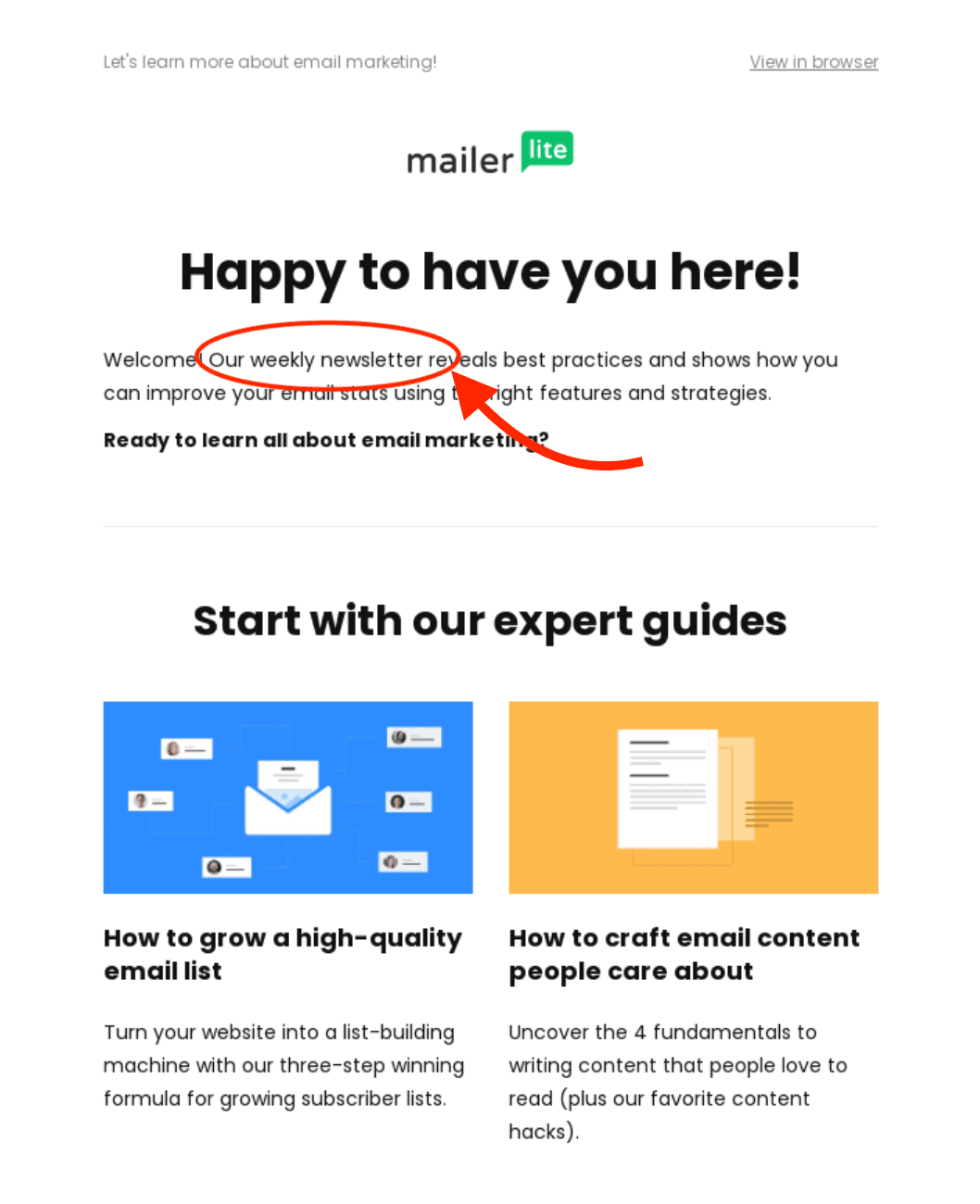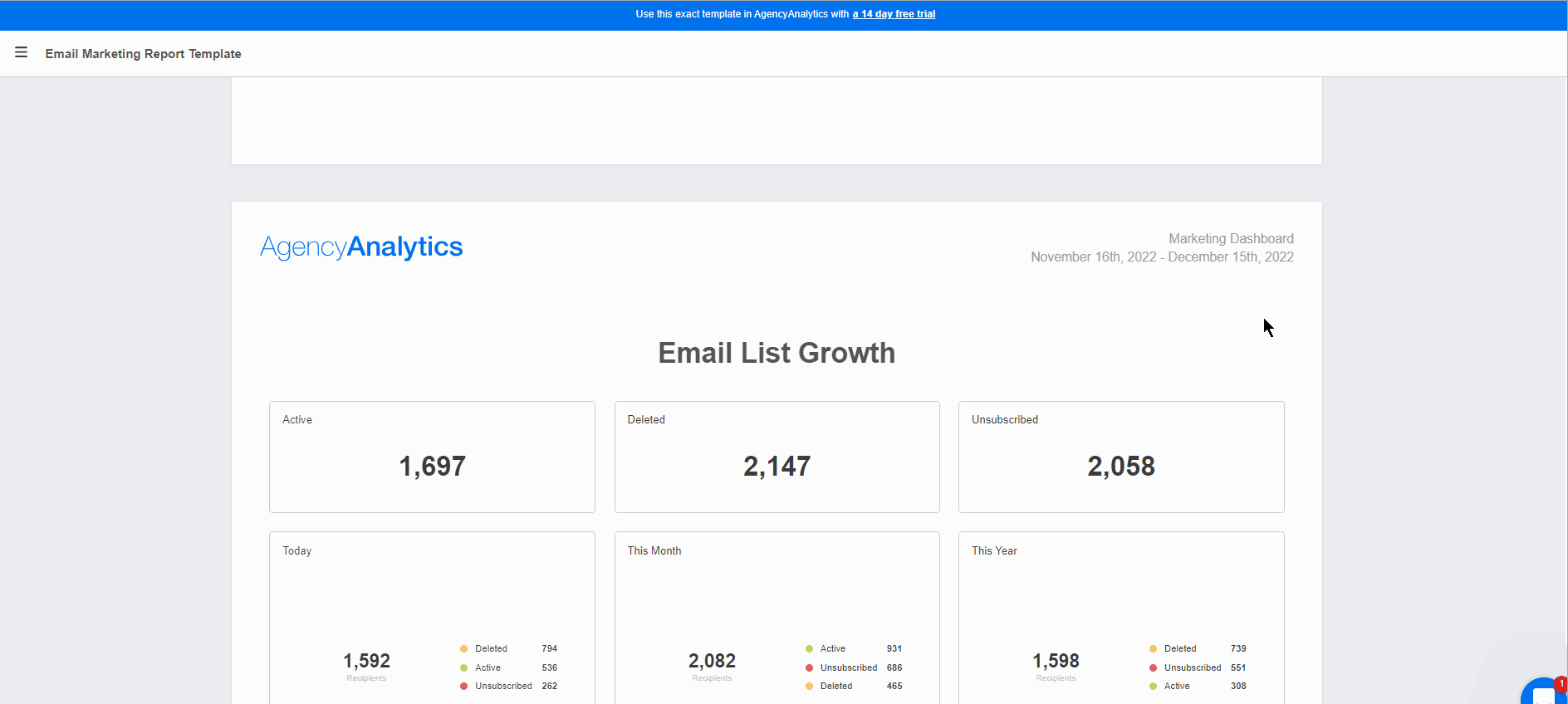Table of Contents
QUICK SUMMARY:
How often should you email your list? The right email frequency impacts click-through rates, subscriber retention, and revenue. This guide shares the best practices for determining the optimal timing and frequency of emails, providing actionable insights to improve your email marketing strategy and drive better results.
Successful email marketing isn’t just about what you have to say but how often and when you say it.
Even the most informative marketing emails or monthly newsletters can lead to spam complaints if you haven’t cracked the code to email frequency. And the immediate effect of it will be a shrinking subscriber list with dwindling email revenue. But is there a magic number to take home? The honest answer is no. (No need to tell this to your clients.)
Even though there isn’t a formula to it, there definitely is a framework to follow that finds the sweet spot.
In this article, we will explore the best practices of when to send your marketing emails and how often to email your list, to reap the real benefits of email marketing.
Impact of Not Planning Your Email Frequency & Time
1. Unsubscribers Go Up
The constant struggle between too many and not enough emails can lead to one typical result: nosediving subscriber count. That's why email sending frequency is so important.
Even if you carefully curate each email with the best intentions, unplanned email frequency risks tanking your efforts. And if no one is listening to you, you are just shooting marketing emails to vacuum. This may also have a residual effect on other goals, like getting more sales.
2. Weak Sender Reputation
Most often, receiving too many emails is the biggest reason why people mark the emails as spam.
And if your mailing list feels the same way about your email communication, it’s one more problem for you to handle. Poor email list hygiene, including things like a high email bounce rate, negatively impacts a sender's reputation. A low sender reputation will limit your reach to even those who are genuinely interested in your communication. Irrelevant subject lines may also be a trigger for unsubscribing.

Use an email reporting dashboard to show clients the health of their lists. Include email bounce rate in your monthly email marketing reports instantly with AgencyAnalytics! Try it free for 14 days.
3. Drop in Engagement
You might be wrong if you think the problem is limited to sending too many marketing emails. Content is important as well. Email subscribers need to be regularly reminded of why they subscribed to your communication, so it's important to keep the messages relevant. Otherwise, sending emails once a month quickly gets forgotten.
They might not mark you spam, but they are not going to engage with your marketing emails if they don't provide value. And sending emails that drive no email click-through rates is no better than sending no emails at all. To make sure your agency doesn't fall into the "no longer relevant" trap, tracking email engagement metrics will tell you what needs fixing.

Automatically visualize email engagement metrics like open rate, click-through rate, and more. Try AgencyAnalytics by signing up for a free 14-day trial today.
4. Poor Conversions
If you aren’t reaching the right subscribers, with the right message, at the right time, you can’t expect them to take the desired action.
Email is a powerful communication tool, and is commonly known as one of the highest ROI channels available to a brand or agency.
But if your audience doesn't engage with your emails because you are sending them too often or at the right time for that audience, you can’t expect the same returns on your investment. That’s why it’s crucial to orient your email communication keeping conversions as your prime goal.
How Often Should You Send Emails?
Before answering this million-dollar question, it’s critical to scan a few things to help make an informed decision.
Business Model: Understand your client's target audience, and whether they deal with a B2B or B2C work model. The user behavior will differ depending on which client type you are dealing with.
Customer Expectations: 61% of the subscribers want to see at least one weekly email in their inbox from the brands they follow, preferably on Tuesdays, Thursdays, and Fridays. But that kind of industry-wide stats doesn't apply to every client. It's better to use data to understand the wants and needs of the target audience.
Marketing Goal: Next, figure out what you wish to achieve with your email communication. For example, does your client want to raise brand awareness or drive conversions? Your goal will help you determine whether a transactional, informational, or promotional campaign will work the best. Subscribers engage with more informative content rather than purely promotional. So if you are sending a promotional email, it's about finding that sweet spot and deciding on a good email marketing frequency (e.g., limiting promotional emails to once a month).

Email marketing frequency will vary for each user and their action. For example, if a subscriber leaves some items in their cart, send emails within 24 hours.
What’s the Best Time to Send an Email?
Research has proven that subscribers are more active on weekdays as compared to weekends. However, there isn’t much variation among the weekdays.
Mondays have the best email open rate of 22%, with Tuesdays getting the highest click-through rate of 2.4%.

The lowest open rate is observed during weekends at just 20%.
You should send emails around noon so that subscribers have ample time to check out your message before signing off for the day. And keep local time zones in mind, so that a recipient in a very different time zone doesn't end up receiving your emails at 3 a.m.
Best Practices For Crushing Email Frequency & Time
1. Give Control to Subscribers
Don’t subject your subscribers to forced communication. Provide them with a control to set their own email preferences.
Rather than a one-size-fits-all subscribe approach, it's best if you ask the subscribers to choose how often and what kind of emails they want to receive. With a subscriber preference option, they pick the types of emails they want to get from you. Not only will this help keep the audience engaged, but will also make sure you focus only on interested subscribers.
When you take away the choice from the audience to regulate the content they want to consume, it could backfire in the form of spam complaints and a poor sender’s reputation.
To gain insights into their decisions, add a quick question to understand their reason for unsubscribing and incorporate their feedback to improve your email marketing campaigns.
2. Segment For Focused Efforts
You can’t weigh all your subscribers on a single scale.
Each subscriber has their unique motivations for consuming your information, and you need to consider this to boost your returns.
The most basic segmentation practice to follow is categorizing your subscribers based on their engagement level.
Primary Subscribers: These are the most active subscribers who interact with most of your emails and should be leveraged for conversions.
Secondary Subscribers: Put the subscribers with occasional interactions into this category in order to improve their engagement with a little push and personalization.
Dormant Subscribers: The subscribers who haven’t responded or taken any action on your monthly emails for a significant amount of time are the lost causes. Removing these from your contacts polishes your mailing list.
Other segmentation options include:
Funnel Source: Those who sign up for a demo of your client's product are usually further down the purchase pipeline than those who subscribe based on their blog content.
Demographics: If your client's primary service area is in the US, these subscribers should get extra care and attention vs. a subscriber from overseas. Use other basic information, such as age, gender, occupation, and income level if they are captured during the signup process.
Firmographics: For B2B email campaigns, target the ideal customer profile using the attributes of a company or organization, such as industry, size, and job title/function.
Purchase history: Segmenting based on past purchases is helpful in targeting specific product interests or purchase patterns.
Website behavior: Tracking website actions such as pages visited or items added to a shopping cart provides valuable insights for segmentation purposes. Use website behavior to trigger marketing automation campaigns when someone in the list visits a key conversion-oriented page.
There are countless other segmentation options to consider, depending on how much you know about your clients' subscribers. The important thing is to gather as much relevant data as possible and use it to create targeted segments for better email performance.
Not only are these segmentation options used to inform the content of emails, but they also help determine the right timing. For example, a high-intent subscriber from a top-converting funnel would indicate more frequent communications, compared to someone who downloaded a whitepaper from a blog post.
Let's dig into some of these concepts further.
3. Study the Client Industry
Each industry has its own customer base, and unless you figure out their needs and wants, there is nothing you can say which will convince them to shell out their money.
Here is how to get insights into your ideal audience.
Begin with basic questions like whether the client serves businesses or customers and identify the user behavior pattern based on that.
Research their competitors and how they are communicating with the audience.
Explore the industry benchmark for email marketing metrics and ROI.
Use surveys and test groups to understand how frequently the customers want email communication.
4. Personalize For Customer Journey
Imagine subscribing to a brand’s email communication and seeing your inbox full of promotional content the next day.
Your first instinct would be to unsubscribe and mark the sender as spam.
It’s critical to understand the customer journey and tweak your email frequency with content accordingly to boost their confidence in you. This will make it easier for your subscribers to complete the desired action.
Reach: This is the first stage of the buyer’s journey where you introduce the brand to them, and is the right time to develop awareness for your business solutions. But ensure you are reaching out to the right audience.
Nurture: The second stage is narrowing down your potential customers and developing a business relationship with them. Regular communication is essential here to maintain relevance.
Retention: Once a customer makes a purchase, the next step is maintaining that pattern. Offering discounts and access to special features is a great way to do so.
Customer Loyalty: A loyal customer base doubles your profits, first by making a purchase themselves and second by referring services to friends and colleagues. It’s a part worth the investment.
5. Set the Right Expectations
First impressions might not be the last, but it definitely impacts the next interaction.
That’s why it’s best not to take any chances and use the first email communication wisely. Welcome emails are a perfect way to introduce your brand and set the right expectations.
Use this opportunity to let your customers know:
What type of content will you share
How often will you email them
What they can do to customize the email frequency

Also, provide an unsubscribe and manage preference option in your email to weed out unhelpful leads.
6. Maintain Consistency With Time & Frequency
Don’t leave your subscribers guessing when your next email will pop up in their inboxes.
It can diminish your credibility, and your customers might miss out on the email altogether. The best way to boost your chances of conversion is to let your subscribers know when and how often you will reach out to them.
Stick to that schedule and plan your communications ahead of time.
Let subscribers change the email frequency. If someone does that, make sure to adhere to the new preference.
If you are planning any changes in your campaign, inform your audience at least two weeks prior.
7. Create Drip Campaigns For User Triggers
You can’t scale if you manually draft each campaign at a leisurely pace.
There are instances where you might have a limited time window to nudge the customer to complete the action. And with each extra hour, the customer might lose interest too.
That’s why automation in email marketing campaigns is a lifesaver. Set up specific user triggers and campaigns that will be sent automatically to the email addresses which meet the trigger check.
For example, let's say that a customer opened the email and clicked on the CTA but didn’t proceed ahead. Here, the user trigger would be clicking on the CTA, and you would send a follow-up email with a discount offer to attract the customer back.
8. Leverage the Right Tools
The right arsenal of tools can reduce your efforts in half.
Aim for automating most of your daily tasks so that you have enough time on your hands to strategize better.
Start with a full-fledged email marketing tool that lets you set up different campaigns, workflows, and drip communication while providing detailed analytics for review.
What should you look for in an email marketing tool?
Ability to handle the large email volume
Custom integration setups
Ease of building campaigns with preferably a drag & drop system
Dedicated IP pool for better deliverability
Accurate analytics
And don’t limit automation to just email designing. Use tools to manage your clients and improve your productivity, too, to get more done in less time.
9. A/B Test Ferociously
Expecting yourself to know everything right in the beginning is unfair.
That’s where A/B testing helps you expedite this learning process. It will let you understand your audience better and see what works best for them.
Many email service providers offer the ability to segment your subscribers into two groups and A/B test them. Send the same campaigns to both groups but with slight changes, like at different times of the day.
Then, analyze both campaigns' performance to see what’s driving the best results.
A/B testing is a proven and continuous method to boost your returns.
10. Ask Your Subscribers For Their Opinion
Consider your subscribers the savior whenever you run into a dead end or find yourself out of ideas to improve.
Roll out regular user feedback surveys to test the waters. It will give you a clear picture of whether they are getting what they expect from you.
Draft a short questionnaire for the primary subscribers. Avoid lengthy questions or minimum word limits, as they can repel the audience.
Let them answer honestly whether the current email frequency and time help them derive the maximum value from your communication.
You can even include a scale of 1 to 10 to get the gist of the feedback.
Measure What Matters
And now, to wrap it up in a neat foolproof package, track critical metrics religiously. Use the tools that give you an accurate picture of your mailing list health. Email service providers offer key insights on:
Opt-out
Open rate
Conversion rate
Deliverability
Manage your content marketing KPIs to move in the right direction with a data-driven approach. When it comes to how often to email your list, email frequency and time are too important aspects of your email marketing strategy to be taken lightly.
The best way is to measure and modify your email strategy for a loyal customer base that stays and grows.

Use AgencyAnalytics' email marketing reporting tool to show clients how effective your email campaigns are. Include them alongside other marketing channels. Start automating your client reporting today with your 14-day free trial!

Written by
Trevor is a managing partner of SendX, a powerful email marketing software for sending campaigns, building your list, and automating your marketing. SendX is a product of SendWorks, a software product suite with tools that help send emails that hit the inbox.
See how 7,000+ marketing agencies help clients win
Free 14-day trial. No credit card required.





